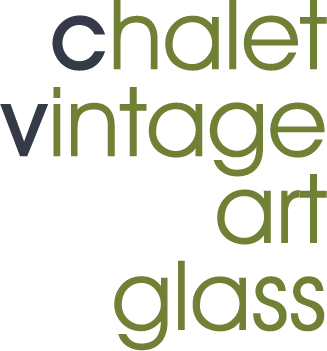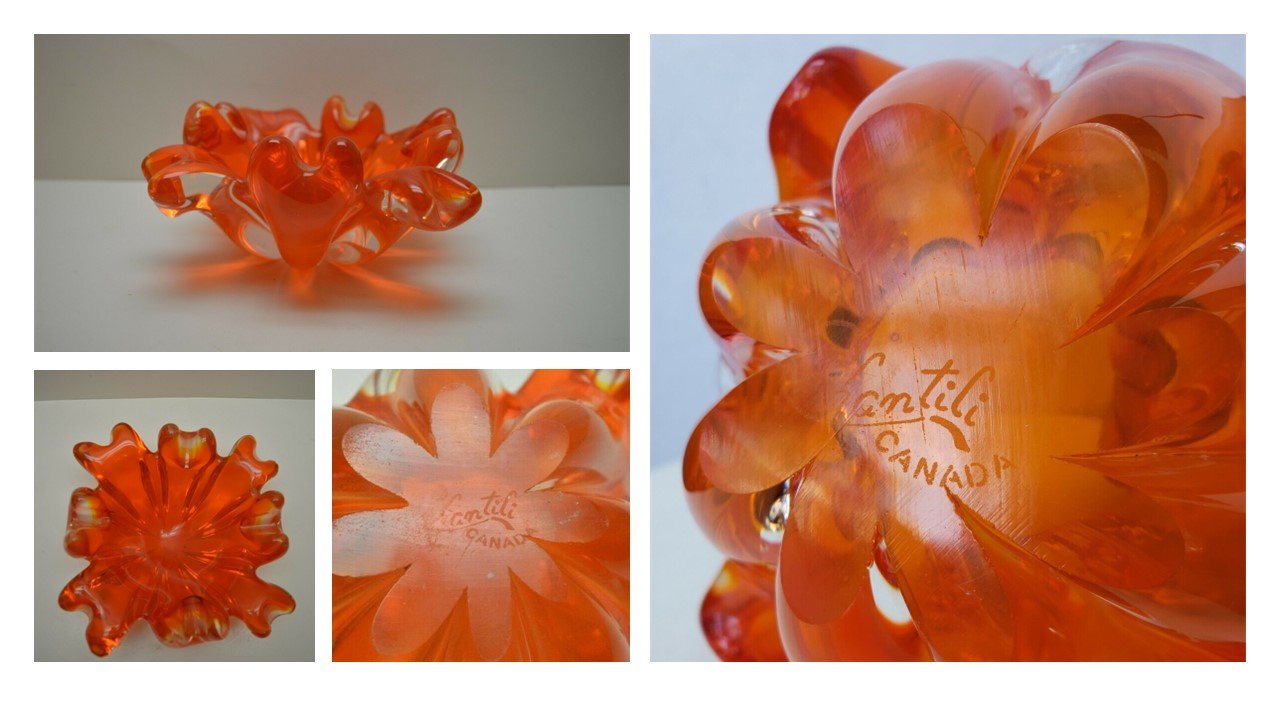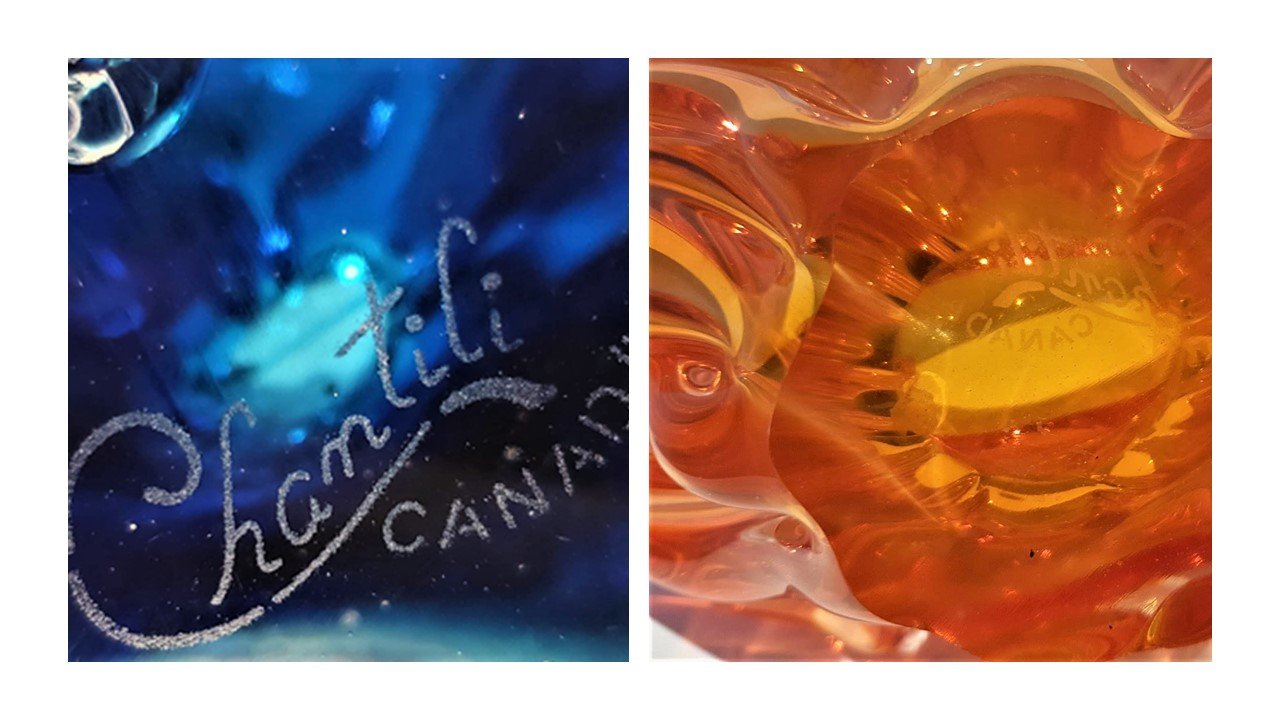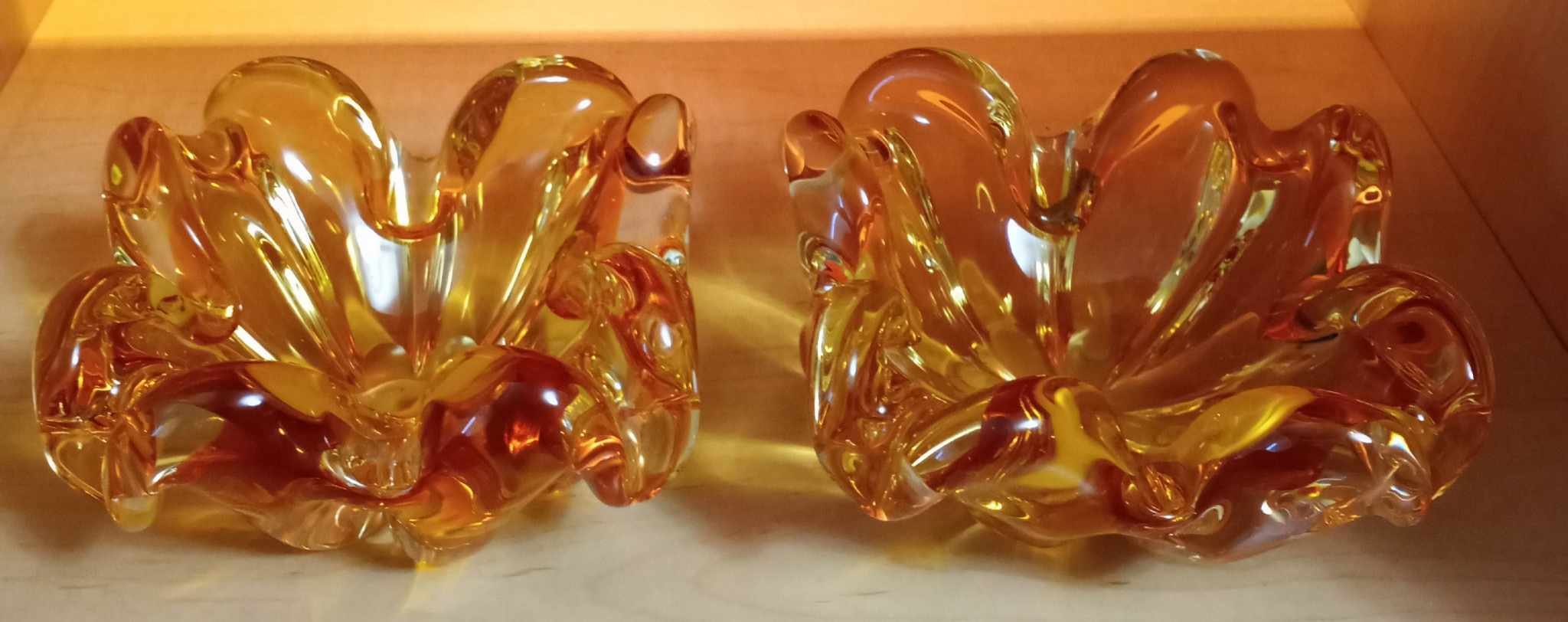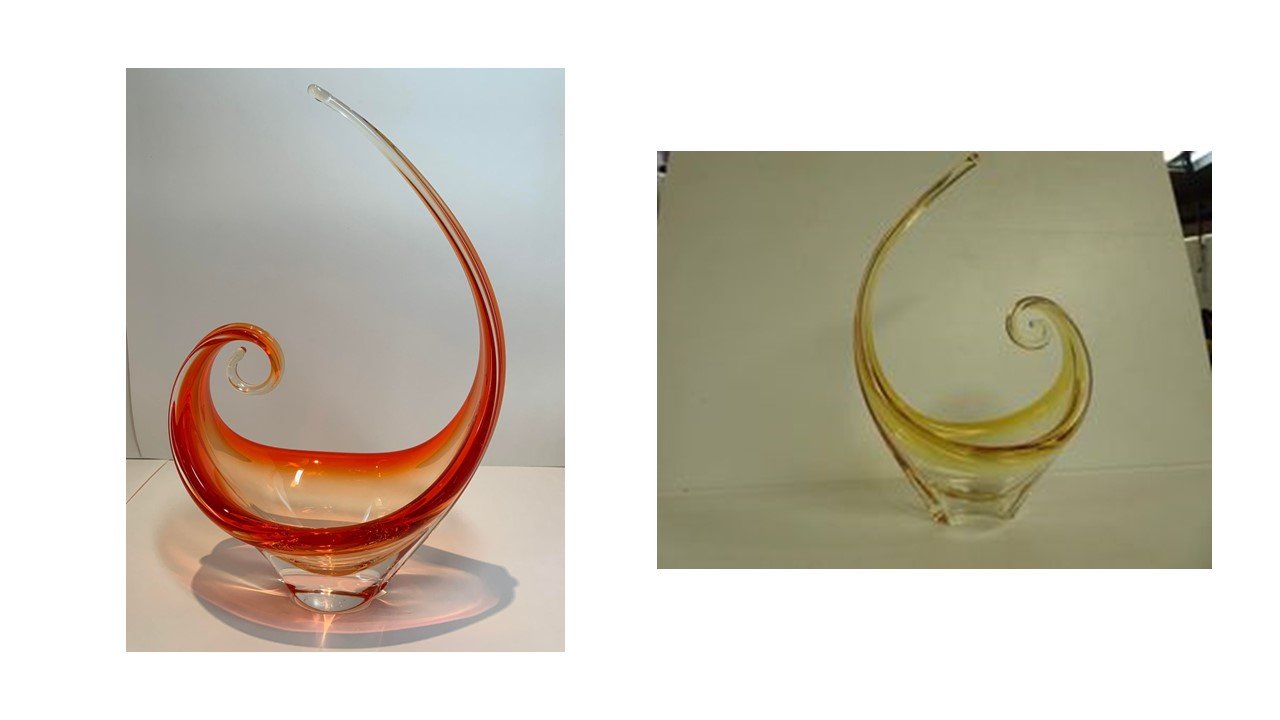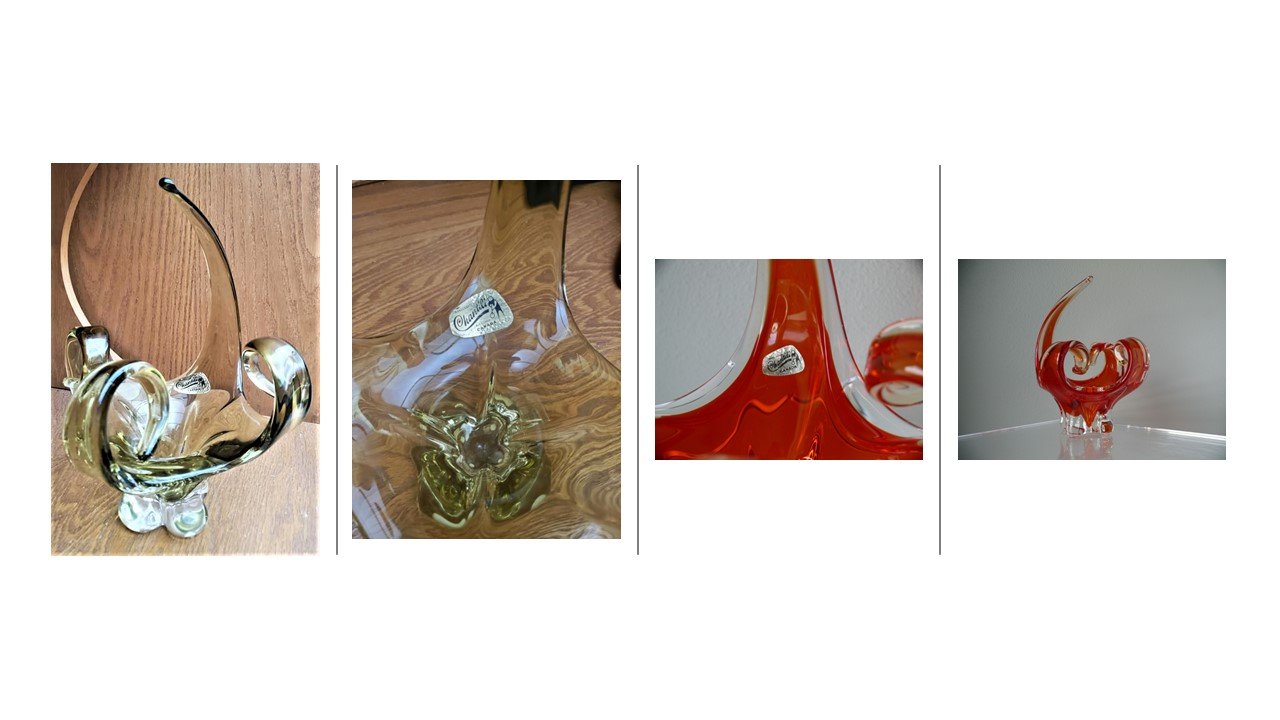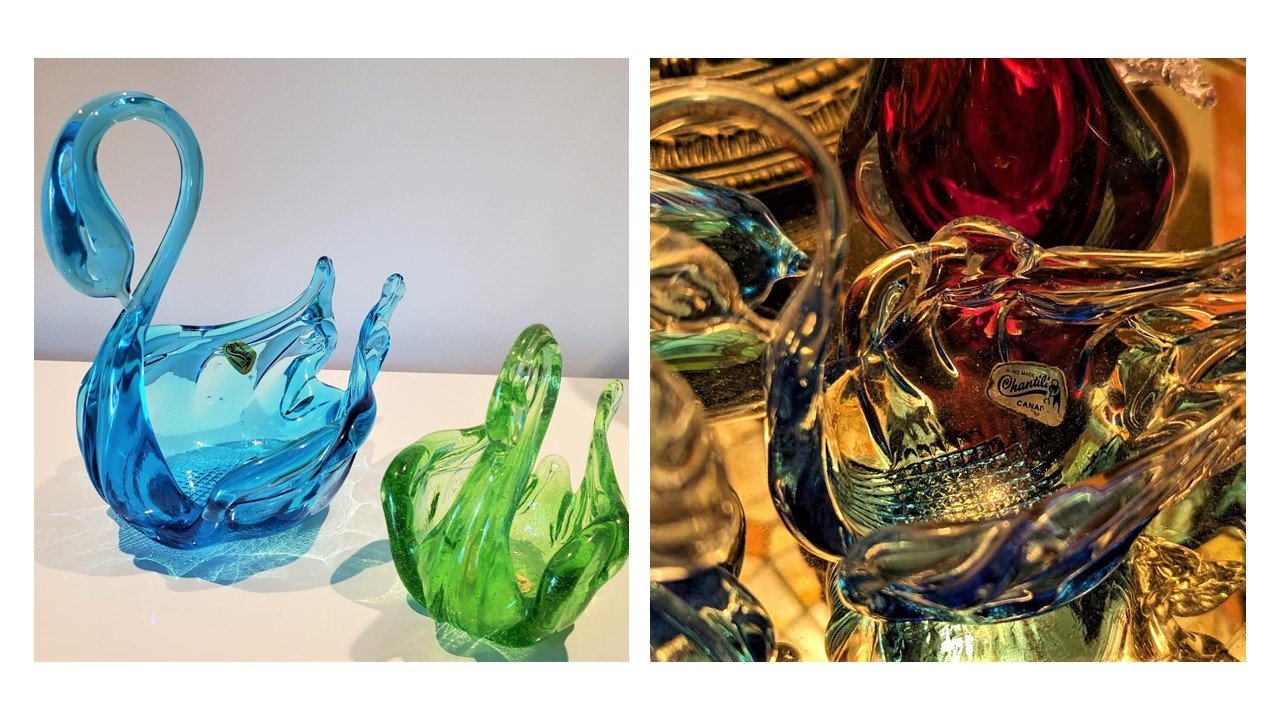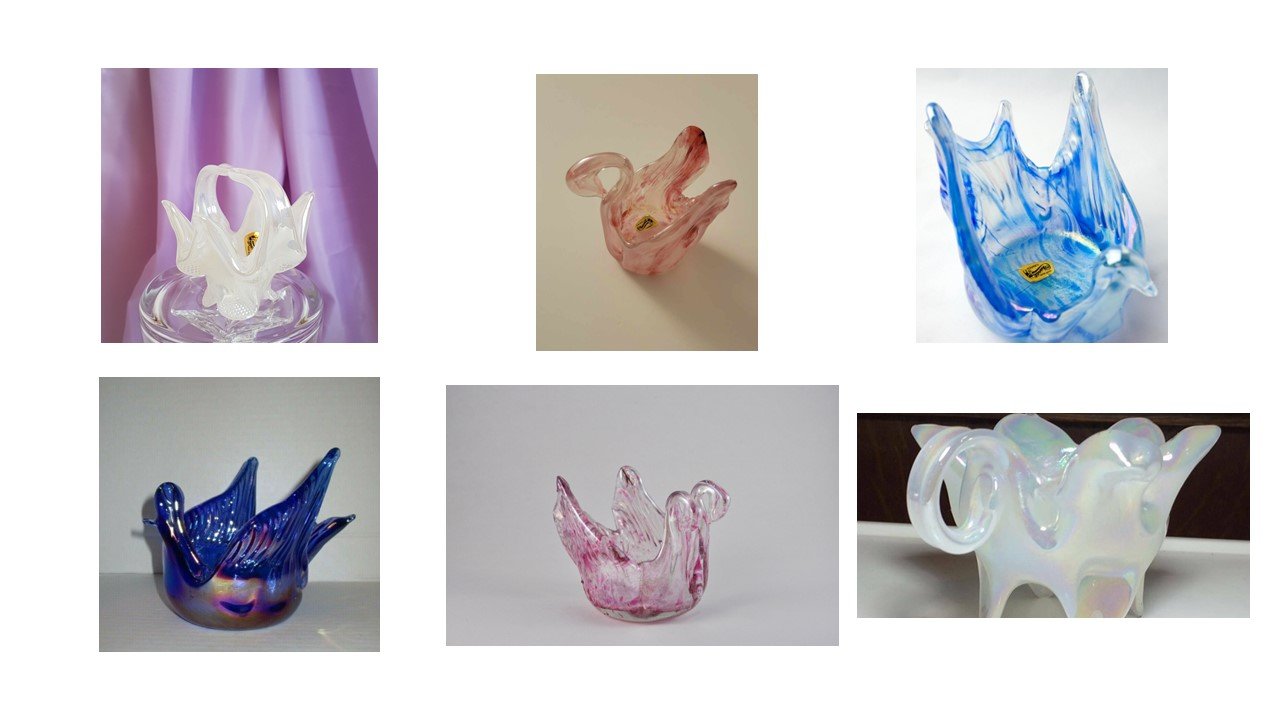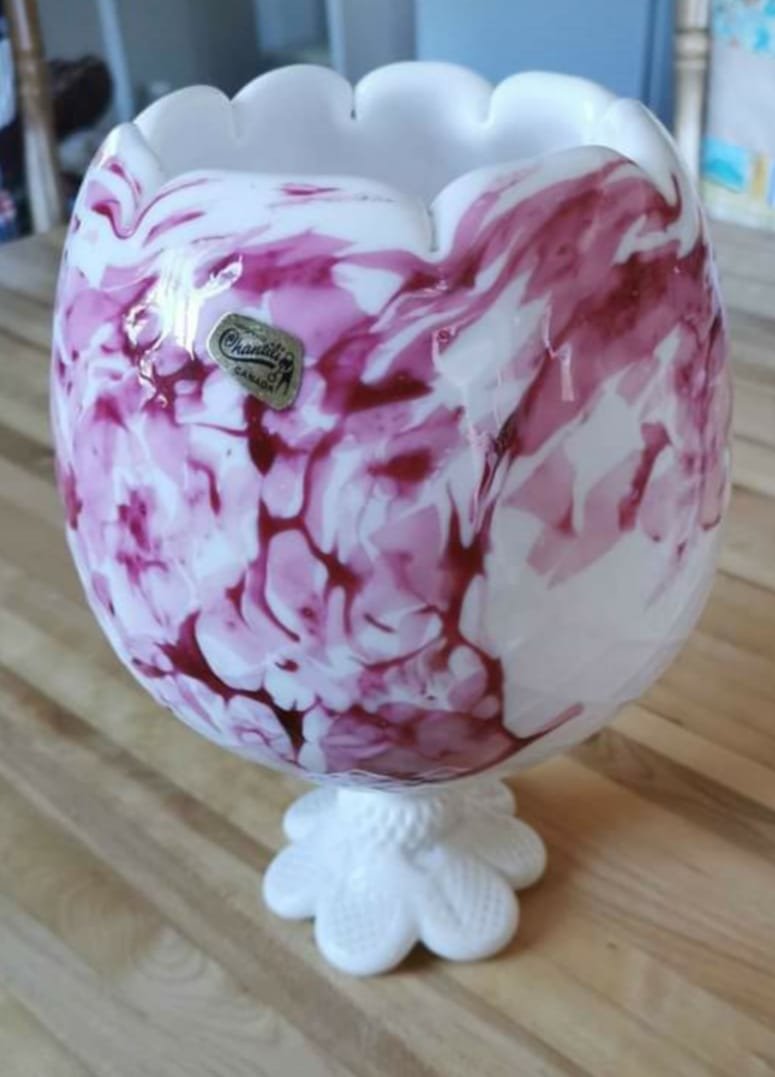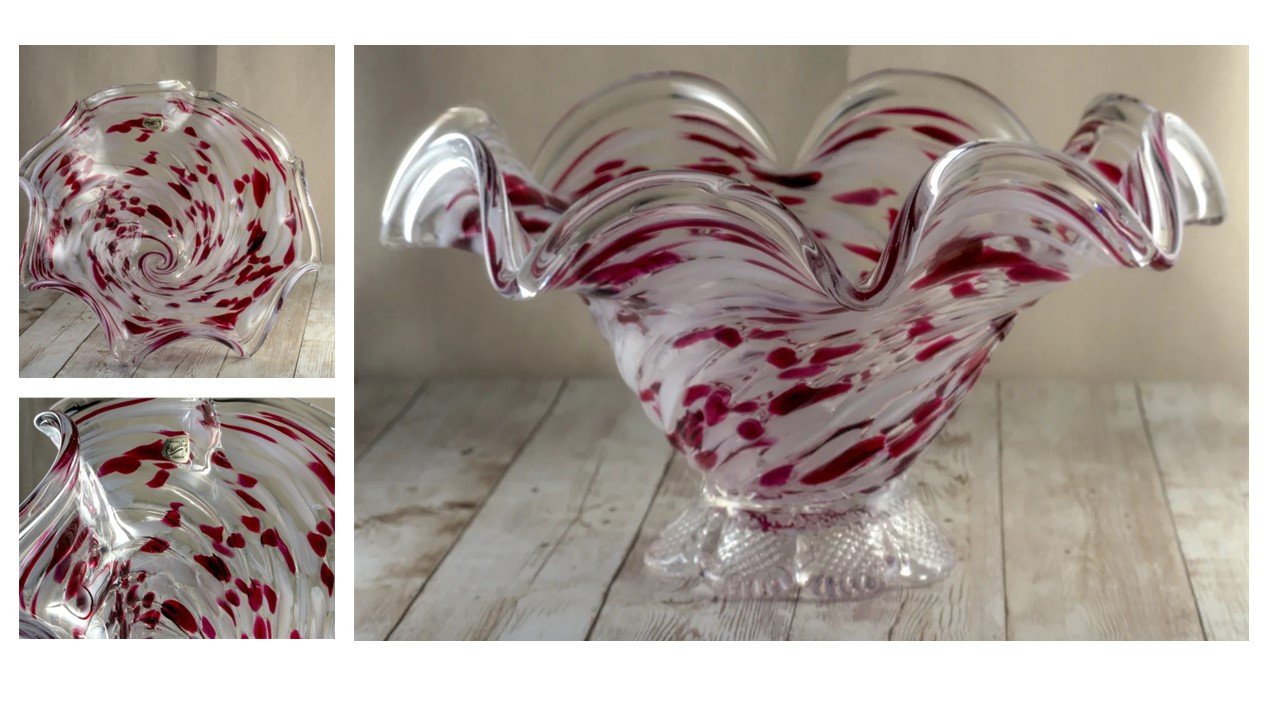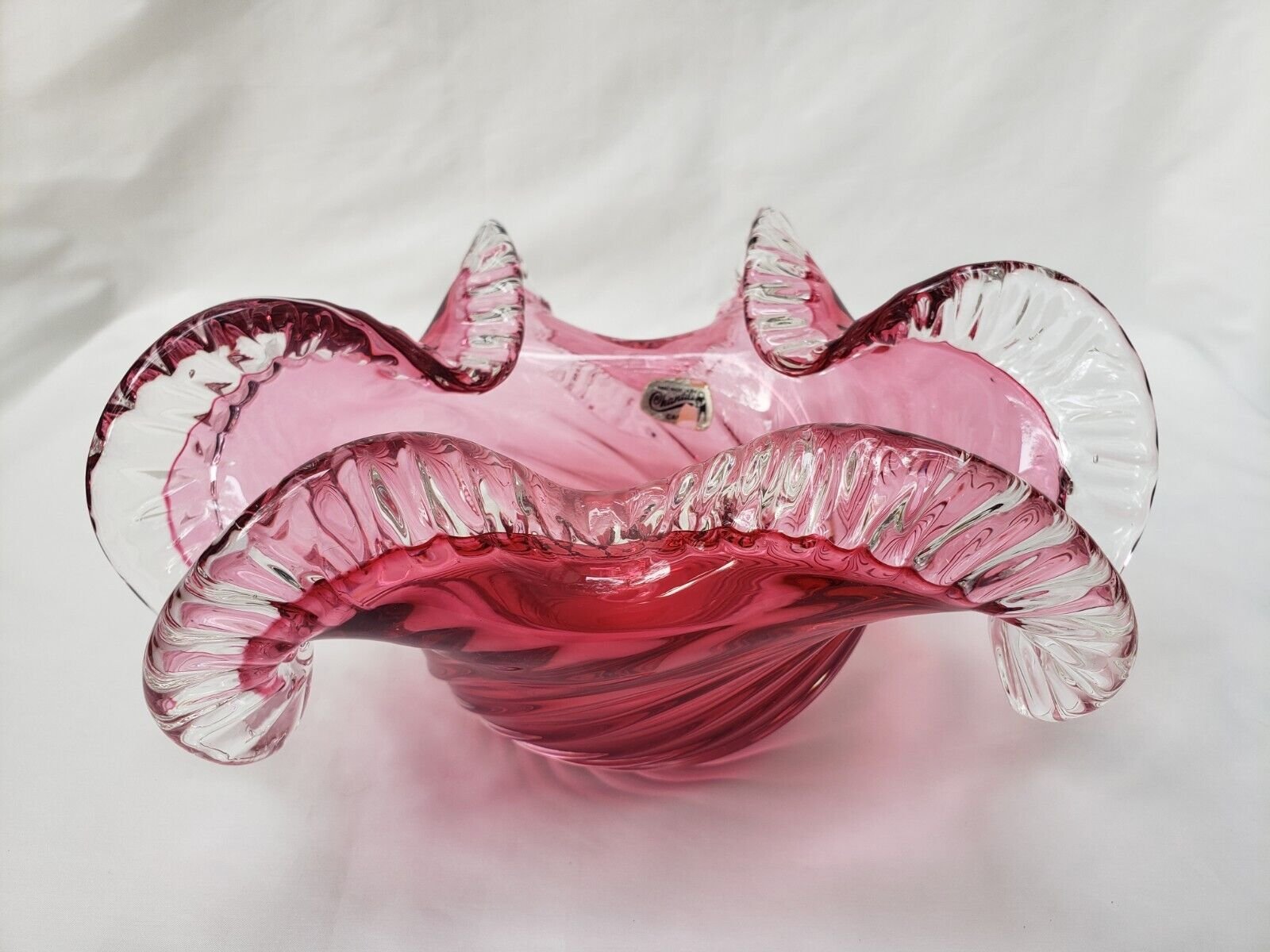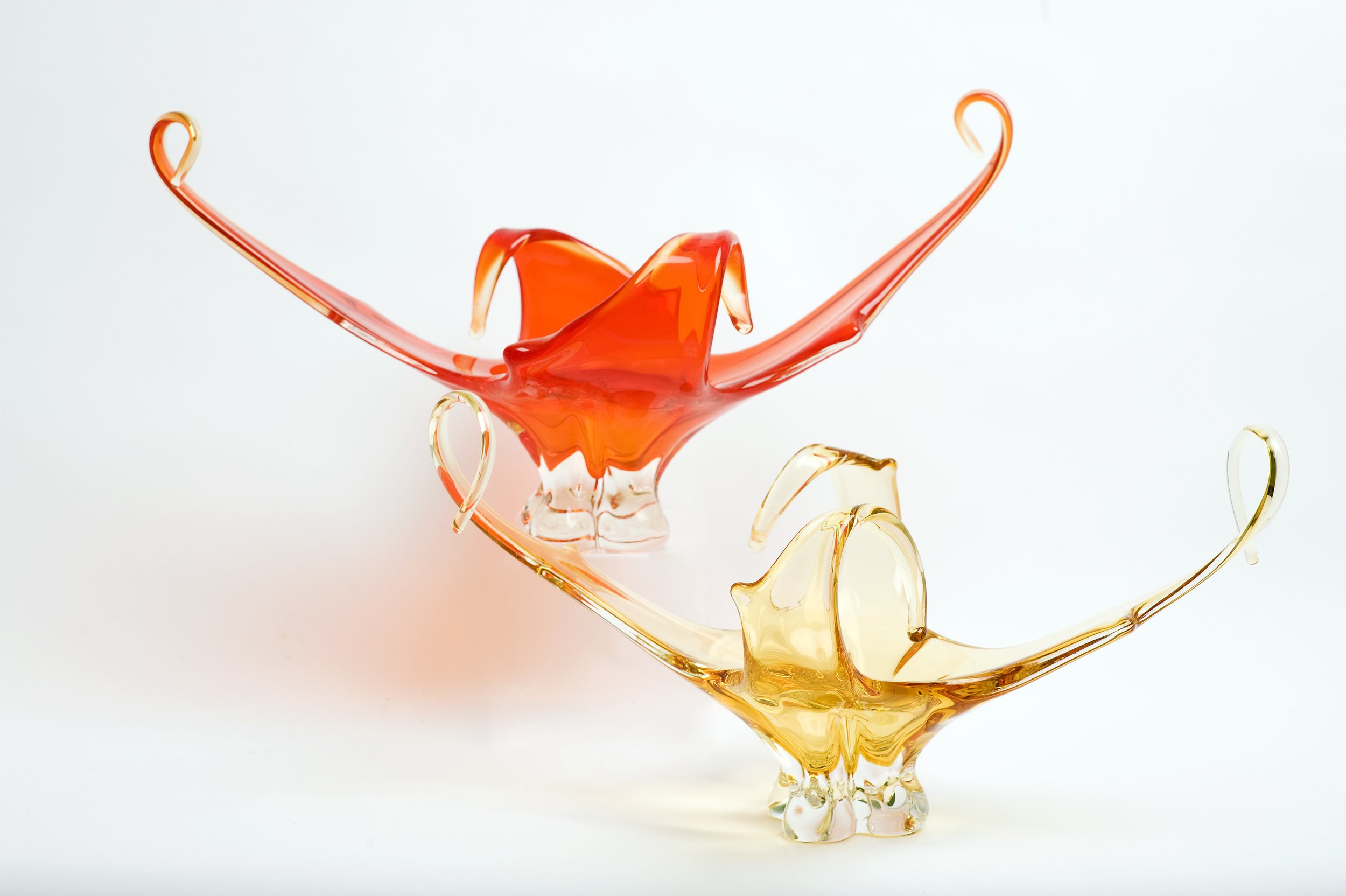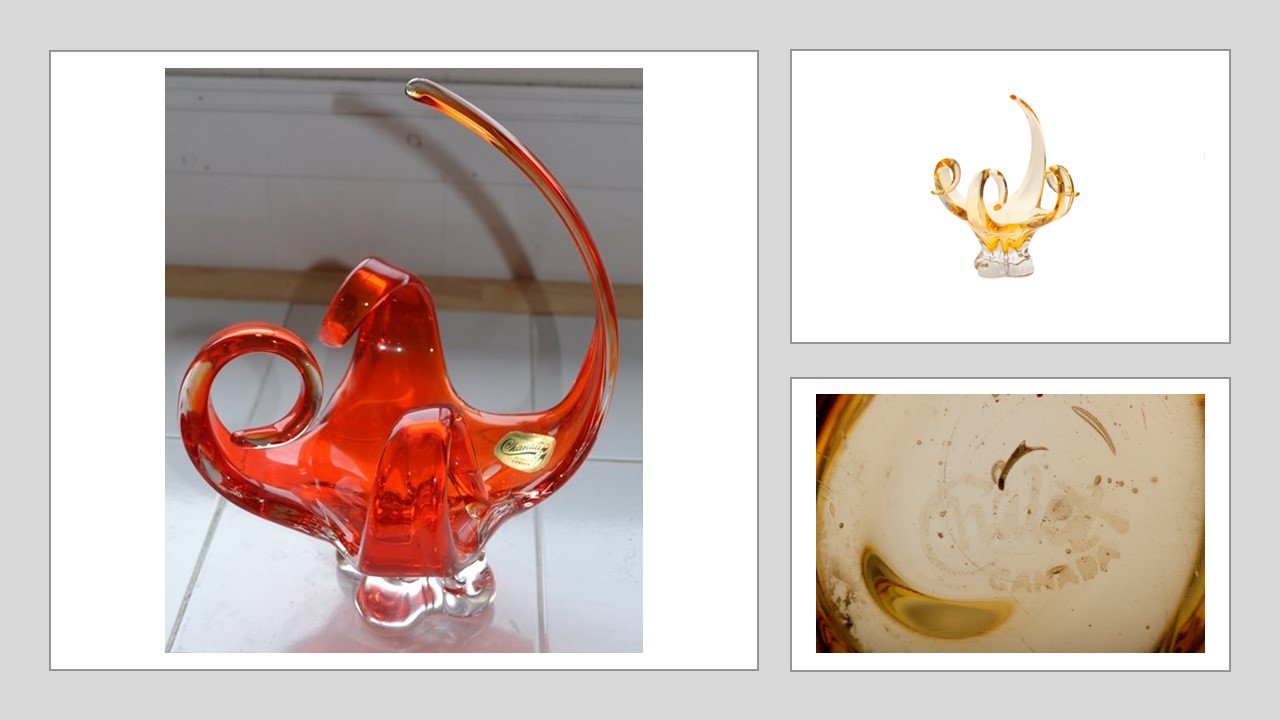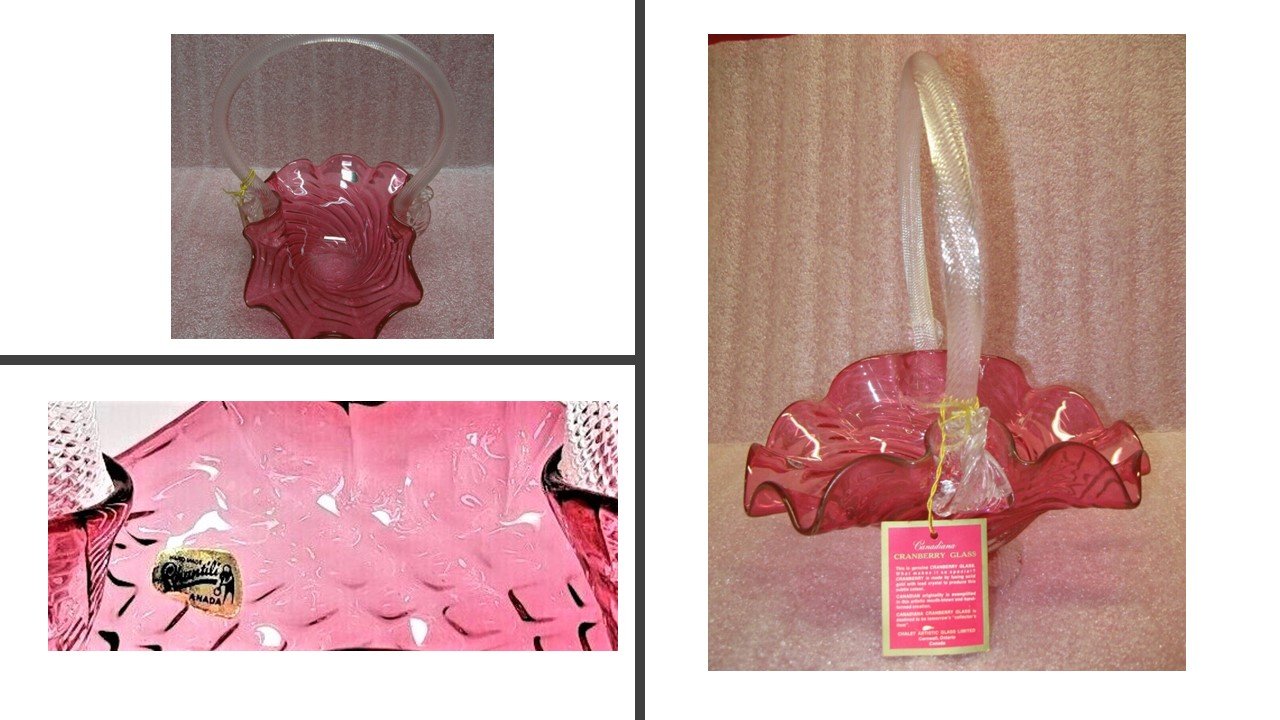Chantili – a Canadian Chalet Distributor
Before concentrating on the details regarding Chalet and Chantili, I need to address some “Chalet confusion.” Specifically, what is a glasshouse, what is a distributor, what is a supplier, what is a retailer and what importers and exporters are. I also feel we should relook at what a “marking” symbolizes.
A glasshouse is: simply, a place where glass is made. Depending on the workplace culture, size, and product output, it can be a workshop, studio, or factory. Chalet was a factory glasshouse.
A distributor is: an entity who purchases bulk amounts of product from a manufacturer and distributes it either directly to consumers or to retailers who then sell to the consumer. Distributors are also sometimes called "wholesalers." From 1962 until 1965, Chalet (the manufacturer) only had one distributor (Tex Novelty) but as the demand for its glass grew, the company acquired several more. Its major Canadian distributors were: Chantili, Tex Novelty, FASCINATION PAR C.M. and N.C. Cameron and Sons. Chalet’s best-known American distributor was Riekes Crisa. Another well known US based distributor was Schmid Brothers.
A supplier is: an organization that produces goods or materials that they then sell to other businesses for use in their own products or services. Chalet acted as a supplier as they sold their glass to many retail businesses. Some had only one storefront such as Pommier Jewellers in Cornwall but they also sold to large jewellery chains like Birks and department store giants like Eaton’s.
A retailer is: a business that sources and buys finished products or services from multiple distributors and/or suppliers and resells them to consumers. Chalet also retailed directly to the public from their factory. Some Chalet distributors also were retailers as well. Chantili had a small retail store in their offices. FASCINATION PAR C.M. had two Montreal locations. One with a retail outlet.
Importers and Exporters: Exporting refers to the selling of goods and services from the home country to a business in a foreign nation. Chalet, therefore, was an exporter when they sold their product to distributors and retailers that operated outside of Canada. Importing refers to the purchase of foreign products and bringing them into one's home country to sell. American distributors such as Riekes Crisa and Schmid Brothers were thereby importers. To date, we can not verify whether Chalet imported the Don Shepherd molded owl pieces or produced them in Cornwall. However, given that none of the glass blowers can recall their manufacture, it is likely that Chalet imported them ready-made, marked them and then resold. If this is the case, Chalet also functioned as an importer and distributor.
A marking is: an authentication or hallmark on an article to indicate its origin and authenticity. Chalet used company etchings, engravings, stickers and hang tags to mark its product. Chalet retailers, distributers and importers quite frequently added their own markings to Chalet products. Very often the Chalet company marking was retained as well but just as typically, it may not have been incorporated. The only consistency in this area is inconsistency.
So, to recap:
Chalet not only manufactured the glass they sold, they also actively participated in selling it. They not only used distributors to wholesale their glass but the company itself also functioned as exporters, suppliers, and retailers. Moreover, there is some evidence that they were also importers and distributors.
Now, let’s look at Chalet’s relationship with Chantili. What Chantil was and was not:
: Chantili was not a glasshouse.
: Chantili was not a Chalet “line” of glass.
: Chantili was a separate company from Chalet – they were not connected through ownership or organizational operation. Chantili was a Montreal based distributor of Chalet product. They had administrative space in the same building as Chalet’s Montreal sales office (the Place Bonaventure business centre) located at 800 Rue De la Gauchetière Ouest.
: Chantili was also a direct reseller of Chalet product as their office space housed a small retail boutique.
Chantili distribution helped put Chalet product into the Montreal area Kmart and KRESGE bargain department stores.
1972 advertising. See circled for the Chantili items. Note that these flyers are also advertising Lorraine Glass Industries pieces. Courtesy of 50 Shades member Mario Panizzon.
Properly marked Chantili pieces never carried Chalet company hallmarks. However, Chalet did do the marking for this distributer so occasionally you will find both companies identifiers on a pieces – examples are given below at end of article. Distribution of Chalet product by Chantili remained consistent with the Chalet corporate branding strategies. Canadian made, quality and craftsmanship were highlighted through both the images (glassblower and canna) and the product descriptions (Canada, hand made and handcrafted art glass) on the stickers as well as through the elegant flowing script used for the etched signatures.
“Chantil CANADA” pieces are found either etched or labeled. Every now and then a piece can be found that has been both etched and stickered. And you can also find the odd one that has a “mismark” with a double or off register signature.
Photograph courtesy of 50 Shades member Russell Brohier.
There are two etched signatures. Each reads “Chantili (in a flowing cursive script) and Canada” (in block capitals). The difference between the two is that one was a reverse etching so “Chantili” can be read from above while the piece is sitting flat. Example on olive centerpiece shown directly below.
This centerpiece, an iconic form distributed by Chantili, bears the reverse etched “Chantili CANADA” signature. Photographs courtesy of 50 Shades member Dustin Rusnell.
This production piece “ 4 butt” ashtray (A#72) bears the “normal” etched “Chantili CANADA” signature.
Photograph on left (of base of basket shown later in article) courtesy of 50 Shades member Cindy Griffith James) has normal signature and base on right (from ashtray shown later in article) has reverse etched signing.
There were also two “Chantili CANADA” stickers. Both are gold foil and have an image of a glassblower holding a canna pointing downward. The differences between the two being size and wording. The larger is not seen as often as the smaller.
Large sticker.
Small sticker.
Small sticker on left with large sticker on right. While the shape of the sticker, the glassblower with canna image and the script font is consistent between the two, note the difference in product description.
Some of the Chalet pieces (namely ashtrays, centerpieces, stretches and baskets) sold and distributed by Chantili were higher end and distinctive. Very similar to other Chalet pieces but with a tweak in shape and style which makes their clarity, casings, weight, elegance of colour, and design especially notable. However, none of these forms were exclusive to Chantili. They were also carried by other distributors (most usually by FASCINATIO||N PAR CM) and are found with Chalet company markings as well. Moreover, Chantili also carried more commonly seen forms of Chalet. Examples are following.
Chantili did not only carry the larger handblown Chalet pieces. Most particularly, they also bought a significant amount of the small glass (they were not crystal) Chalet hand-molded bomboniere. These trinkets were primarily for the Montreal wedding market. They were filled with salted or candied almonds or mints, wrapped in netting, and used as table favours. Bomboniere were also gifted to guests at other special gatherings such as baptisms, first communions, bridal showers ...
Chalet animals, mushrooms and Christmas trees have also been found with Chantili labels. And most surprisingly, many pieces from the hand molded Canadian Heritage Glass and the three other hand molded cranberry lines.
Let’s get close up and personal with each of these forms.
The following styles of ashtray are often etched or stickered “Chantili CANADA”:
This “8 butt” ashtray has also been found in orange with a Chantili sticker.
Can be marked with either the Chantili etched signature or stickered with labels and have been found with Chantili markings in blue, orange and gold as well. Photograph courtesy of 50 Shades member Stephen Malcolmson.
Chalet produced very few pieces with coloured bases – only a handful have been found. To date, this is the only coloured base ashtray etched Chantili of which we are aware. Another of the “butterfly” design.
As shown above.
This “2 butt” olive rimmed ashtray is very seldom seen. It has been found in gold as well. Etched.
Another small “4 butt” production ashtray (A#74) etched “Chantil CANADA.” It has also been found in orange. Photograph courtesy of 50 Shades member Pina Pina.
Styles of basket forms often etched or stickered Chantili:
From the collection of 50 Shades member Kevin Hall.
At left from the collection of 50 Shades member Dwain Robertson. Middle Deborah Patterson and at right, photograph courtesy of Roger Lambert.
At left from the collection of 50 Shades member Cindy Griffith James (etched base of basket shown above) and at right, photograph courtesy of Laura Kaulka.
From the collection of 50 Shades member Jay Miller.
Styles of centerpiece forms seen etched or stickered “Chantili CANADA”:
Starting with a grouping of three pieces that trigger an initial and oft correct; “Betcha they are Chantili.”
All etched with the Chantili signature. From the collection of Deborah Patterson.
This form is also found marked Chantili in gold rimmed. Pieces on the right are from the collection of 50 Shades member Jo Highland.
The gold “moustache gondola” form shown in the grouping above is also found marked Chantili in blue as well as olive and orange.
The third form from the grouping above has been found both stickered and etched Chantili. It was produced in the full range of the Chalet palette. Centerpiece at top left from the collection of 50 Shades member Ella Hanks. At top right from the collection of 50 Shades member Dustin Rusnell. At lower left from the collection of 50 Shades member Brad McGillivray. At lower right from the collection of 50 Shades member Cindy Bishop-Laughlin.
As well as the three shapes shown directly above, the shapes shown in the four galleries immediately following are often found with Chantili markings. However, please note that almost all were retailed by FASCINATION PAR C.M too – as shown on that distributor’s catalog page below.
Piece on left from the collection of 50 Shades member Brad McGillivray. Middle Deborah Patterson and at right, from the collection of Ella Hanks.
Olive piece at right from the collection of 50 Shades member Alex Wicks.
From the collections of 50 Shades members Dawn Davis (left) and Ella Hanks (right). It has also been found in olive with a Chantili marking.
More shapes that are also found etched or stickered ”Chantili CANADA:”
Photograph courtesy of 50 Shades member Brad McGillivray. Etched.
Rare 2-tone on the left is from the collection of 50 Shades member Melody Carter. The gold rimmed piece on the right is also seldom seen. Both etched with the Chantili signature.
Familiar shapes that can be found etched or stickered ”Chantili CANADA:”
These centerpieces are from the collections of 50 Shades members Kathie Elmhurst (left) and Ella Hanks (right).
From the collections of 50 Shades members. Gold gondola belongs to Gionny Gueli, blue to John Panjuer and the olive to Donna Piasetzki.
Styles of long arm stretches often etched or stickered “Chantili CANADA”:
Both etched Chantili Canada. Orange at left from the collection of Deborah Patterson and the red centerpiece on the right is from the collection of 50 Shades member Dawn Tolhurst.
Chantili marked vase forms are scarcer. However, we have found a range of forms.
Blue “splash” vase on left from the collection of 50 Shades member Stephen Malcolmson.
From the collection of 50 Shades member Candace Nestorowich.
Note the label remnant on the vase at top right. It is faded but unmistakable.
Orange “crystal twist” vase at right from the collection of 50 Shades member Ella Hanks.
I have only ever seen three amberina pieces. Two of this style of vase (#842) and a pitcher (style #801). And this vase is the only Chantili marked one – the other pieces were unmarked.
The smaller pieces do not seem to have been etched. It would have been much more time and cost effective to label. Some small and rarer pieces that are stickered “Chantili CANADA”:
All the Chantili marked Christmas trees that I have seen have been the green.
The animals that we have found that are stickered “Chantili CANADA”:
From the collection of 50 Shades member Tracey Court.
From the collection of 50 Shades member Lise Legare-Kowalchuk.
This is the only clear crystal seal figurine that I know of to date.
As stated above, Chantili purchased and distributed a significant amount of the Chalet hand molded bonbonniere. When I was interviewing Maestri Panizzon and Gatto and Chalet artist Gianfranco Guarnieri in 2010 for “The Shapes and Colours of Chalet Art Glass”, they told me that Chantili also sold these directly to the public out of the retail boutique at their office space.
Chantili stickered bonbonniere have been found in a wide range of styles. Most are commoner shapes with typical finishes in typical colours. However, we have found some rare ones which are less than typical in shape and finish.
Some of the more commonly seen:
Basket bonbonniere in lower right from the collection of 50 Shades member Caroline Lorna.
As illustrated by the photograph on the left, more than one size of swan bonbonniere (as per the Chalet production sheets) have been found with Chantili markings. Swan in photograph on the right from the collection of 50 Shades member Kevin Hall.
Irradato and opalescent finishes and opaline:
At right, a swan bonbonniere from the collection of 50 Shades member Keri Williams.
From the collections of 50 Shades members Gionny Gueli (left) and Ella Hanks (right).
Two very rare:
6 pull pink irradato bonbonniere at left from the collection of 50 Shades member Betty Clarke while the green irradato basket at right is from the collection of
50 Shades member Kevin Hall.
Now I am going to show something that surprised me while doing research for this article. And what was that? I discovered that Chantili also distributed a fair amount of the larger hand molded pieces from all four of those lines – the Canadiana Cranberry, Canadian Heritage Glass, End of Day, and Opal with Cranberry.
From the Opal and Cranberry line:
From the collection of 50 Shades member Brad McGillivray.
In addition to the 2-tone amberina vase shown above, another piece from the “Canadian Heritage Glass” line:
From the “End of Day” line:
And from the “Canadiana Cranberry” line:
As I stated earlier, although Chantili did distribute some distinctive pieces, the impression or belief that they were an exclusive channel for any one piece or line of Chalet product is incorrect. Chalet supplied many retailers with the same product and other distributors also carried the same Chalet stock that we have found Chantili stickered or etched.
Some samples as proof positive:
This vase form has been found etched “Chalet Canada” (orange, top left) while the blue (bottom left) retains a Chantili sticker. It is also featured in the top right of the FASCINATION PAR C.M. catalogue page shown here. The orange vase is from the collection of 50 Shades member Reg Paulson. You will note that the majority of forms on this catalogue page have been shown above with Chantili etchings and stickers.
This grouping of “round head” owls is another excellent illustration of non-exclusivity regarding distributors and inventory.
The 2-tone on the left bears a Chantili sticker while the 2-tone in the middle (lower) is etched “Chalet Canada.” The clear at the right (yellow tinge is from too much lead in the mix) retains a Chalet sticker and the clear in the middle background is marked with the N.C. Cameron and Sons label. And we know that Riekes Crisa also carried this form in clear crustal as it is shown in their 1976 catalogue as part of Assortment #7228-69.
Additional examples of same form with more than one major distributor other than Chantili:
Please note that the deer on its side (right) retains the early N.C. Cameron and Sons Ltd. sticker. This label is very rare.
Chantili marked wolf (left) and N.C. Cameron wolf at right. This is the later label.
Chantili marked tree (left) and N.C. Cameron tree at right.
Chantili was not the only distributor of the Canadian Heritage Glass line – Chalet and N. C. Cameron and Sons Chalet also supplied retailers. The blue vase retaining a remnant of that distributer’s sticker is from the collection of the Cornwall Community Museum
And the Chalet hand molded glass is also shown in the 1976 Riekes catalogue.
RoyCraft (Tex Novelty distributorship) stickered swan on left and Chantili marked at right.
Riekes Crisa (included in Assortment #7261-69) at left and Chantili at right.
Chantili stickered basket on left and FASCINATION PAR C.M. etched basket on right. Both are from the collection of 50 Shades member Kevin Hall.
Chantili etched ashtray on left and FASCINATION PAR C.M. etched ashtray on right which also is from the collection of 50 Shades member Kevin Hall.
The following are pieces that have been found marked with Chalet company hallmarks as well as being found with Chantili markings.
This Chantili marked “splash” vase from the collection of 50 Shades Stephen Malcolmson is an “exception to the rule” regarding the marking of this iconic form. It is most typically found with Chalet company etching or big black label.
The catalogue sheets and inventory numbers for the Chalet bonbonnieres are one of the most comprehensive refences we have
The Chantili stickered “shell’ bonbonniere from the collection of 50 Shades member Jo Highland and the swan photographs courtesy of Joshua Dolstra.
Two blue butterflies bearing both Chalet and Chantili markings. The stickered Chalet (left) is from the collection of the Cornwall Community Museum. The etched Chantili on the left is from the collection of 50 Shades member Pina Pina.
Another iconic form showing both a Chantili etching (left) and a Chalet label (right).
The orange stretch in the background is etched “Chantili CANADA” while the gold is etched “Chalet Canada.”
The large baskets on the outer left and right were also retailed in department stores. This style is often found with the etched <E> as well which designated Eaton’s. In this case, the gold is signed “Chalet Canada” while the blue (from the collection of 50 Shades member Daniel Lynch) is etched Chantili. The gold “bridal basket” in the middle was etched “Chalet Canada” and also retained the small gold foil Chalet “Lead Crystal” sticker. The blue bridal basket from the collection of 50 Shades memberJay Miller is etched with the Chantili signature as shown above earlier.
Same form – different markings. Photographs courtesy of 50 Shades member Jeremiah Shaver.
Same form, same colour but differently marked fungi. 50 Shades member Cindy Bishop-Laughlin’s mushroom (left) is etched “Chalet Canada” while Melissa Patterson’s piece retains its “Chantili CANADA” label.
The gold basket on the left is etched Chantili and, as above, was also distributed by FASCINATION PAR C.M. Its blue counterpart bears the Chalet etched signature. It is from the collection of 50 Shades member Cindy Bishop-Loughlin. The 2 middle baskets also bear different etchings with the amethyst being signed “Chalet Canada” and the gold being signed “Chantili CANADA.”
This gold ashtray from the collection of 50 Shades member Carolyn McPherson (top left) is shown on a Chalet catalogue page as #A72. As is the Chantili stickered “8 butt” (#A71) in the lower left corner.
And yet another key signature form (#B2) marked in two different ways.
Photograph on left courtesy of Linda Leanna.
On the following two cranberry pieces, both the pitcher and the basket carry a Chalet hang tag as well as the Chantili sticker.
From the collection of 50 Shades member Pina Pina.
As a fitting end to this article, a “Chantili tribute” to the saying; “A picture is worth a thousand words.”
All these Chantili etched and stickered forms are from the collection of 50 Shades Lorne Olafson and Darcy Dietrich. .
